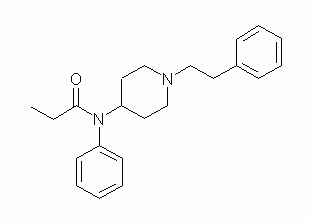METHOD OF PREPARATION
Note: This preparation should he prepared in a laminar airflow hood in a cleanroom or via isolation barrier technology by a validated aseptic compounding pharmacist using strict aseptic technique. This is a high-risk preparation.
1. Calculate the required quantity of each ingredient for the total amount to be prepared.
2. Accurately weigh and/or measure each ingredient.
3. Dissolve the fentanyl citrate and sodium chloride in about 95 mL of sterile water for injection.
4. Adjust the pH, if necessary, to the pIT range 4.0 to 7.5.
5. Add sufficient sterile water for injection to volume and mix well.
6. Filter through a sterile 0.220 -µm lilter into a pump cassette or other appropriate container.
7. Package and label.
PACKAGING
Package in tight, light-resistant containers.1
LABELING
Keep out of reach of children. Use only as directed. Store in a refrigerator.
STABILITY
If sterility tested: A beyond-use date of up to 24 hours at room temperature, up to 3 days at refrigerated temperature (2 to 8°C), or up to 45 days if frozen can be used for this preparation.'
If not sterility tested: A bcyond-use date of up to 14 days stored in a refrigerator can be used for this preparation.1
USE
Fentanyl citrate injection is used in the treatment of chronic, severe pain.
QUALITY CONTROL
Quality-control assessment can include weight/volume, physical observation, pH, specific gravity, osmolaliry, assay, color, clarity, paniculate matter, sterility and pyrogcnicity.2,3
DISCUSSION
Fentanyl is a synthetic phenylpiperidine-derivative opiate agonist used as a sedative, analgesic, preoperative medication, and adjunct to general or regional anesthesia and in the management of chronic pain. Fentanyl is commercially available in a number of dosage forms, including a 50-µg/mL injection. Higher concentrations are required, however, in pumps for chronic administration.
Fentanyl citrate (C^sub 22^H^sub 28^N^sub 2^O.C^sub 6^H^sub 8^O^sub 7^, MW 528.6) occurs as white granules or as a white, glistening, crystalline powder. It melts at about 150°C, with decomposition. Fcntanyl citrate 157 µg is approximately equal to 100 µg of fentanyl. Tt is soluble l g in 40 mL of water and slightly soluble in alcohol. Fentanyl Citrate Injection USP contains not less than 90.0% and not more than 110.0% of the labeled amount of fentanyl, present as the citrate. It should be protected from light. The pH of the injection is between 4.0 and 7.S.1,4
Sodium chloride (NaCl, MW 58.44) is available as a white crystalline powder or as colorless crystals. It has a saline taste and is used in a variety of parenteral and nonparenteral pharmaceutical formulations.5
Sodium hydroxide (NaOH, MW 40.00, caustic soda, soda lye) occurs as dry, very deliquescent, white or almost white sticks, pellets or fused masses that are hard and brittle. It is strongly alkaline and corrosive and rapidly absorbs moisture and carbon dioxide when it is exposed to air. It is soluble l g in 1 mL of water and is freely soluble in alcohol. A 0.01% solution in water has a pH of not less than 11.0. It should be stored in airtight, nonmetallic containers.4
Citric acid (C^sub 6^H^sub 8^O^sub 7^,H^sub 2^O, MW210.24, citric acid monohydrate) occurs as colorless or translucent crystals, or as a white crystalline, efflorescent powder that is odorless and has a strong, tart, acidic taste. Its melting point is about 100°C, but it softens at about 75°C. One gram is soluble in less than 1 mL of water and 1.5 mL of cthanol.6
Sterile water for injection is water for injection that has been sterilized and suitably packaged; it contains no added substance.'
REFERENCES
1. United States Pharmacopeial Convention, Inc. United States Pharmacopeia 27-NationalFormulary22. Rockville, MD: US Pharmacopeial Convention, Inc.; 2004: 785-786,1950,2345-2349,2762.
2. Alien LV Jr. Standard operating procedure for paniculate testing for sterile products. /JPC1998;2(1):78.
3. Alien LVJr. Standard operating procedure: Quality assessment for injectable solutions. /JPC1999; 3(5): 406-407.
4. Reynolds JE, ed. MARTINDALE: The Extra Pharmacopeia. 30th ed. London: The Pharmaceutical Press; 1993:1076-1077,1415.
5. Owen SC. Sodium chloride. In: Rowe RC, Sheskey PJ1 Weller PJ, eds. Handbook of Pharmaceutical Excipients. 4th ed. Washington, DC: American Pharmaceutical Association; 2003: 556-559.
6. Amidon GE. Citric acid monohydrate. In: Rowe RC, Sheskey PJ, Weller PJ, eds. Handbook of Pharmaceutical Excipients. 4th ed. Washington, DC: American Pharmaceutical Association; 2003: 158-160.
Copyright International Journal of Pharmaceutical Compounding Jan/Feb 2005
Provided by ProQuest Information and Learning Company. All rights Reserved



